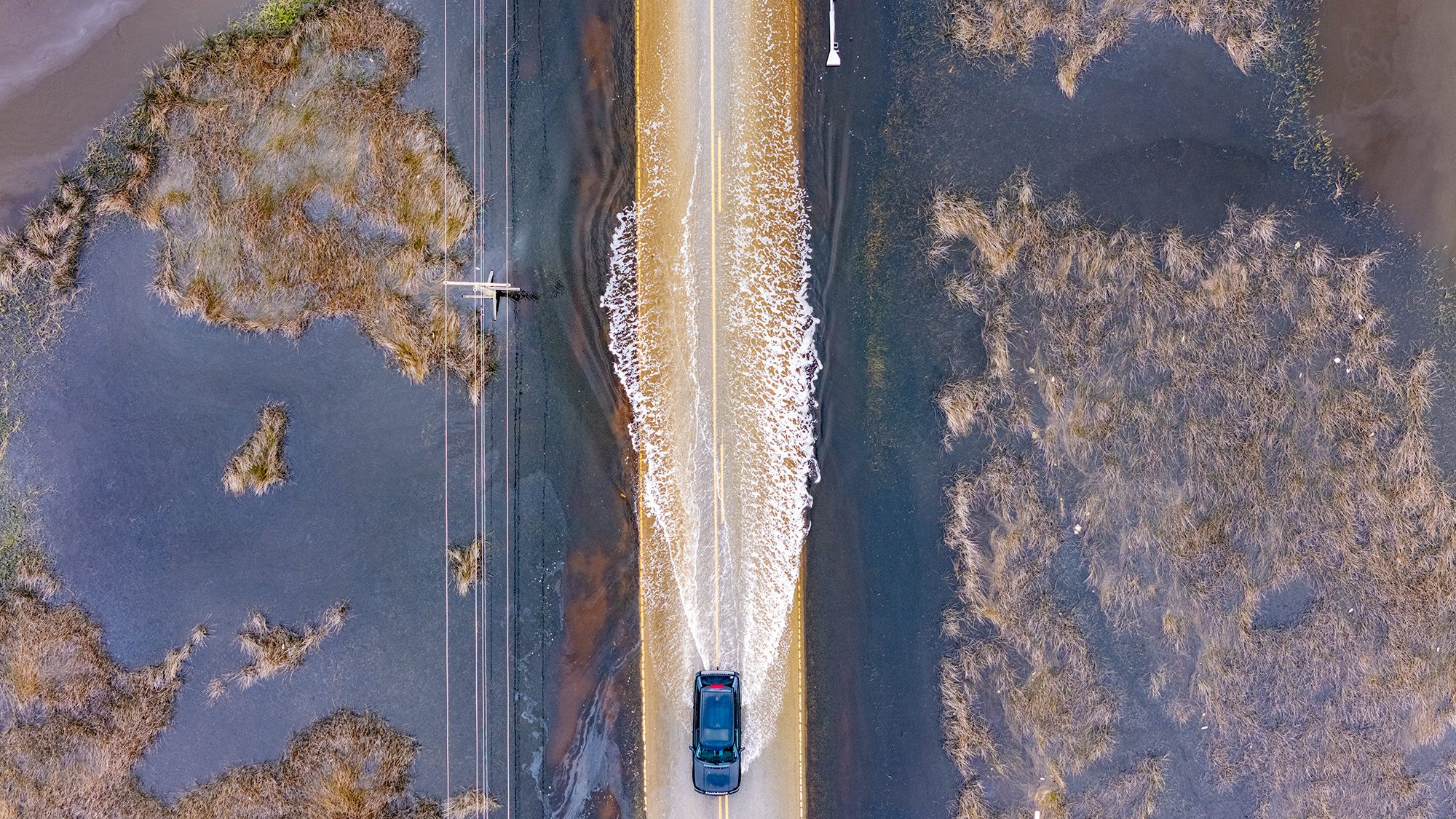Clamming does not have to be too strenuous. You can float around with just your head stuck out of the water, and use your fingers and toes to find and dig out clams. It’s a great way to lie back, relax, and think about the world, and still feel productive. You usually end up with a good mess of clams for dinner.
I remember going clamming in Bogue Sound with my father one fall morning 31 years ago. That particular day has stuck in my memory because we talked about what I could do after college. I was about to graduate in December from UNC with a master’s in city and regional planning and only had some temporary research work lined up with a professor.
Supporter Spotlight
Only a few weeks before I turned down a job offer in Florida. Tampa needed someone to work to reduce the amount of stormwater pollution in its bay, and the job was a match for my experience. What wasn’t a good match was Tampa Bay. Walking down to the seawall next the bay after my job interview, I saw thousands of dead fish floating belly up. The thought of moving to a city by a polluted bay as opposed to being able to walk out my back door and catch clams would have been a very tough adjustment, but it still took all the courage I could muster to turn down a good job and paycheck.
What really seemed like an exciting prospect was the idea of becoming a paid advocate for the N.C. coast. Some of the research I’d done in college exposed me to people who worked for conservation organizations around the country. I’d observed a strong correlation between independent citizen-based groups and stronger and more effective environmental protection programs.
While we clammed, I told my father about what I really wanted to do, but how there were no coastal environmental groups in North Carolina with enough money to hire me. He said not to be discouraged. “Where there’s a void to be filled there’s opportunity,” he advised.
That turned out to be good insight, and at that I decided to make a run at forming a coastal organization for which I could work. The thought “nothing ventured, nothing gained” gave me some internal confidence to go forward. With the encouragement of my entire family, friends and people who I met along the way, the idea of forming the N.C. Coastal Federation began to gel.
My professor and boss at UNC, Ray Burby, provided a few hundred dollars through a now defunct organization called the N.C. Land Use Congress to support an exploratory meeting about whether a new coastal group was needed. That meeting was April 22, 1982, and about 65 people came to what’s now called the Aquarium at Pine Knoll Shores to attend. It was co-sponsored by eight civic groups including Carteret County Crossroads, The Neuse River Foundation, The Pamlico-Tar River Foundation and others.
Supporter Spotlight
The idea of having one group that helped to engage and inform people’s involvement on a coast-wide basis was explored. No one said it was a stupid idea or not needed. That was enough of an opening to start putting together an initial board of directors, and a good group of respectable people was enlisted who either saw the potential for the organization or who might have just wanted to humor me.
Then there was the challenge of coming up with a formal name for the organization. I’d like to tell you there was a lot of research and forethought that went into the decision. In truth, the name was decided on the 30-minute drive from Jacksonville to Ocean after a Coastal Resources Commission meeting.
Ted Ullman, a youthful board member of Carteret County Crossroads, gave me a ride in his vintage Chevy Impala (that lacked a good muffler). Over the roar of his old car, we talked about numerous possible names, and Ted observed that we were really talking about a “federation” of groups. As we drove into my yard, we decided that the N.C. Coastal Federation would be a good name, and that decision stuck.
Next there was the issue of how pay for the organization. The only real hope of getting enough money to hire any staff was to get a grant. Engaging local people in deciding if large-scale peat mining of wetlands should be allowed was a hot issue that provided a good opportunity to test of the concept of the federation. I wrote a proposal to the Mary Reynolds Babcock Foundation that outlined what we could do. The Babcock Foundation had a reputation back then for being willing to provide seed money for good ideas and upstart organizations.
There was no stationary for a cover letter for the proposal, and so a pen and ink drawing of a brown pelican that my sister Deede had drawn for me for school project years before was pasted on a piece of paper, and a single piece of letterhead was made with a typewriter. It looked semi-professional, but it was the best I could pull off.
The foundation reviewed the proposal and wanted to hear more. I received an invite for an interview in Winston-Salem to chat, and asked Derb Carter, who at that time worked for the National Wildlife Federation in Raleigh, to help me at the meeting. Together we were convincing enough to make it on the final docket that fall.
Meanwhile, I was running out of money to live and had begun looking around for more traditional planning jobs. If the grant had been turned down, no one other than me would even remember the fledgling N.C. Coastal Federation today.
Just a few days before Thanksgiving word came that a $20,000 grant had been approved. With these funds, and a few extra dollars collected from elsewhere, the federation’s budget grew from a few hundred dollars in 1982 to a huge budget of $28,000 in 1983. It even gave me a salary of $1,000 each month.
Looking back over the last 30 years makes my head spin. That shouldn’t be too surprising, because the nature of the federation’s work still makes me dizzy just about every day. There is constantly an amazing array of opportunities and challenges that prevent any complacency and boredom.
Ronald Reagan years ago asked the question: Are you better off than you were four years ago? We need to ask a similar question about our work – Is the coast better off than it would have been if the N.C. Coastal Federation did not exist?
In my opinion, the answer is a resounding yes!
Our three program areas include advocacy, education and habitat restoration and preservation. These programs are like three legs of a stool. Together they support our mission to engage people of all walks of life in coastal decision-making. We’ve continued to work to keep these legs of our programs in balance so that the stool does not topple over. We simply can’t get too far out ahead of our coastal communities with our efforts—without their real engagement and support we would simply be spinning our wheels when it comes to coastal protection and restoration.
There are many hundreds of thousands of acres of protected land, tens of thousands of acres of restored wetlands and fisheries habitats and enhanced coastal development practices that have come about because of our work. These things have been accomplished because we’ve engaged our decision-makers at every level of government, held them accountable for their actions and worked to engage and educate people of all ages and walks of life regarding our coast and its needs.
This brings me to reflect on the secrets to our successes. There are three main reasons why we’ve had a productive 30 years of work. They include:
- We rely on synergy to get results. Synergy is two or more things functioning together to produce a result not independently obtainable. We’ve always work to tap into the ability to outperform even our best individual efforts because we know that we can’t protect or restore the coast by ourselves. It’s always been clear that an effective organization is more than the sum of its parts. Synergy is the ability of a group to outperform even its best individual member. We don’t shy away from the fact that there are many points of disagreement among the people with whom we work to protect and restore the coast. Instead, we actively look beyond these disagreements for areas of mutual interest. The value added by working with so many diverse people as a whole, beyond that contributed independently by each individual, is created primarily by the lasting relationships we build over time.
- We use the tools of our democracy and have faith that when we exercise them, people will make good choices regarding our coast. As the legendary environmentalist David Brower once said, no environmental victory is ever final. Over and over again, we have proven that when people come together and have a civil and informed process by which they make decisions regarding our coast, those decisions are generally more favorable to environmental protection. When real public engagement is lacking, then bad choices get made. There are no shortcuts to our work – we have to help people understand the real choices that must be made and how best they can exercise their power to help direct those choices. We’re actually very fortunate to have many avenues of access to governmental decision-making; however, engaging people in those decisions is a constant chore that simply can’t be ignored.
- People make the difference. What has inspired me to stay involved in this work for so many years are the people who I get to know? Time and again individuals have stepped forward in ways that just amaze me—using their expertise, energy, imaginations, fortitude, money and thousands of other assets to lend a hand to help us with our mission.
Many times I’ve joked that the only reason the federation was formed was because I needed a job, and no one else would hire me. The truth is that being able to earn a living doing something that you really care about remains a big motivating factor for all of us who work for the federation. Not wasting away one’s life doing someone else’s dirty work was another valuable insight I learned from my father as well.
Since no conservation victory on our coast is ever permanent, there will always be the need for the federation to tap into and cultivate the capacity of people to provide for good coastal stewardship. Thirty years from now I’m very confident that a group of people will assemble to celebrate another milestone in the history of the federation and the coast. Many of us won’t be around for that anniversary, just like so many of the early supporters of the federation aren’t here to celebrate with us today.
The enduring ability of the federation to function as a positive force for coastal protection and restoration exists because so many people work together so well. Thank you for being part of the legacy of the N.C. Coastal Federation.







